Gujarat Board GSEB Textbook Solutions Class 12 Commerce Accounts Part 2 Chapter 4 Analysis of Financial Statements Textbook Exercise Questions and Answers.
Gujarat Board Textbook Solutions Class 12 Accounts Part 2 Chapter 4 Analysis of Financial Statements
GSEB Class 12 Accounts Analysis of Financial Statements Text Book Questions and Answers
1. Select the correct option for each question :
Question 1.
Which of the following analysis shows stakeholder-based classification?
(A) External analysis
(B) Horizontal analysis
(C) Short-term analysis
(D) Vertical analysis
Answer:
(A) External analysis
Question 2.
How many assets are analysed in the financial statement analysis?
(A) 1
(B) 2
(C) 3
(D) 4
Answer:
(D) 4
Question 3.
The information regarding the use of assets gives the analysis of ……………………. .
(A) profitability
(B) liquidity
(C) solvency
(D) efficiency
Answer:
(D) efficiency
Question 4.
The analysis of the financial statements ……………………….. .
(A) presents only results
(B) provides historical information
(C) makes interpretation
(D) none of the above
Answer:
(C) makes interpretation
![]()
Question 5.
The expenses of the current year of a company is ₹ 6,00,000; and if it is increased by 20% compared to the previous year, what would be the expenses of the previous year?
(A) ₹ 1,20,000
(B) ₹ 5,00,000
(C) ₹ 7,20,000
(D) None of these
Answer:
(B) ₹ 5,00,000
2. Answer the following questions in one sentence :
Question 1.
What is financial analysis?
Answer:
Interpretation of information or result given in financial statements is known as financial analysis.
Question 2.
Describe the types of financial analysis on the basis of parties.
Answer:
On the basis of parties types of financial analysis are as follows :
- External party
- Internal party.
Question 3.
Describe the types of financial analysis on the basis of time.
Answer:
On the basis of time, types of financial analysis are as follows :
- Long term analysis
- Short term analysis
Question 4.
What is horizontal analysis?
Answer:
If the process of analysis or comparison of financial statements of different years is done from left-hand side to right-hand side means in horizontal form, then that type of analysis is known as horizontal analysis.
![]()
Question 5.
What is vertical analysis?
Answer:
The comparative analysis for one year among different units of different financial statements can be called as vertical analysis.
Vertical analysis is used to compare the performance of different units or departments of one year with the help of different predetermined ratios.
3. Answer the following questions in brief :
Question 1.
Describe the different types of financial analysis.
Answer:
Different types of financial analysis are as follows :

(1) On the Basis of Stakeholders: Financial statements of a business entity are used by various stakeholders. These stakeholders can be categories into two parts :
(i) External party
(ii) Internal party.
(i) External Analysis: External parties like potential investors, financial institutions government agencies, credit rating agencies, researchers etc. take decision of investments or other decision through financial statement analysis which is known as external analysis.
(ii) Internal Analysis: The management of the business take their decision from accounts prepared by them. The base of these decisions is analysis. When financial statements are analysed by the management for their decisions is known as internal analysis. The information available for this kind of analysis is accurate and elaborate.
(2) Horizontal-Vertical Form: This kind of analysis can be done in two ways :
(i) In the horizontal form and
(ii) In the vertical form.
(i) Horizontal analysis: If the process of analysis or comparison of financial statements of different years done from left-hand side of right-hand side means in the form of horizontal then that analysis is known as horizontal analysis.
This analysis is done for long term planning. This analysis is useful to know the current trend. This analysis is known as time series analysis.
(ii) Vertical analysis: The comparative analysis for one year among different units of different financial statements can be called as vertical analysis.
This analysis is used to compare the performance of different units or departments of one year with the help of different predetermined ratios.
![]()
(3) On the Basis of Duration: Analysis of financial statements of a business unit can be done into two sections in the context of time:
(i) Long term analysis
(ii) Short term analysis.
(i) Long-term analysis: Many stakeholders like debenture holders, financial institutions, potential investors undertake long-term analysis of financial statements before investing their funds in the corporate form of business. For this analysis information of more than one year is needed. Under this analysis, these stakeholders determine the present and future long-term solvency, profitability, liquidity and efficiency of the borrowers.
(ii) Short-term analysis: This kind of analysis is used to measure short-term solvency or liquidity of the business entity. This kind of analysis is done by the short-term lenders as well as the suppliers of row materials.
Question 2.
Discuss any three objectives of financial analysis.
Answer:
Important objectives of financial analysis are as follows :
1. Efficiency evaluation: Business entity acquires different assets as per the nature of business with the help of this assets production and sales are done and services are provided. The use of these assets should be at maximum level. Maximum use of assets generates more earning. Through financial analysis, the evaluation of the efficient use of assets can be done.
2. Evaluation of earning capacity: Generally, financial statements are prepared for the duration of 12 months. This analysis is made with the help of different accounting ratios and future earning capacity of the entity can also be forecasted. Mostly all stakeholders, gather information of present and future earning through this analysis for their
investment decision.
3. Solvency evaluation: Solvency evaluation has two types: Short term and long term solvency. The goods and service providers to the business measure the short term solvency and banks and financial institutions measure the long term solvency of business entities for their loan amount.
4. Evaluation of managerial efficiency: The owners and the management are two different entities in the company form of business. Therefore, through financial analysis evaluation of effectiveness and fairness of the decisions of the board of directors can be done. The performance evaluation of the officers can also be done throught this analysis.
5. Planning for budget: Budget means the quantitative planning or statistical planning of future objectives in present. What will be the future sales? How much purchase is required? How much will be the production? How much cash will be required? What will be the revenue expenses? What will be the capital expenses? etc. are estimated. Analysis of financial statements is useful to make the process of budget effective.
6. Comparative Study: Two types of comparisons can be done through financial analysis. In the first comparison, the business entity can compare its currents with the accounts of past. Different aspects of business entity like profitability, liquidity, solvency and efficiency etc. of the current year can be compared with the previous year to know the growth of the above-mentioned aspects.
7. Simplicity to understand accounts: Financial accounts are prepared on the basis of determined rules, principles and terminology. It is possible that all the users of financial accounts may not have full knowledge pertaining to financial accounts. Under these circumstances, financial statements analysis helps to understand the financial accounts. In financial analysis, the presentation of financial accounts is done in various ways. It provides simplicity to the users to understand financial accounts.
Question 3.
Discuss any three uses of financial analysis.
Answer:
Main three uses of financial analysis are as follows :
1. For dividend decision : In the company form dividend decision is analysed by different parties like existing investors, potential investors and company itself. The payment of dividend is based on earning capacity of company which can be decided by profitability analysis and to take proper decision regarding dividend payment financial statement is useful.
2. For lending decision: short term and long term loan and advances are provided to the business entities by banks and financial institutions. To know how far their advances are safe, financial statement analysis is useful.
3. For borrowing decision: From the analysis of financial statements of their own, business entity can estimate its own borrowings capacity to borrow funds from the market. Based on this evaluation, opportunities for new investments can be explored.
Question 4.
Discuss any three limitations of financial analysis.
Answer:
Following are the main limitations of financial statement analysis :
1. Historical data: Financial accounts are prepared on the basis of past transactions, so we can say that financial statement is based on historical information. Based on analysis of financial statement, future of business entity can be forecasted. So, here estimation is possible which is biggest limitation.
2. Absence of qualitative aspect: Factors like honesty, expertise, contribution of workers for development of business and loyalty of management towards business entity etc. are not considered which have relation with efficiency of business. This is again a limitation.
3. Window dressing: Many a time, the information disclosed in financial statement is not found to be correct. Accounts are prepared on the basis of incorrect information rather than correct information. Thus, decisions made by the stakeholders stand incorrect. This is also a limitation.
4. Absence of Qualitative Aspect: During financial statement analysis only quantifiable items are considered. But factors like contribution of workers for development of business and loyalty of management towards business entity, honesty, expertise etc. are ignored.
5. Personal opinion: There are options in accounting for preparing the accounts, i.e. Use of inventory valuation and depreciation method. Thus, there is a possibility of personal opinion. Due of these options, there is a room for subjectivity in preparation of accounts. This also creates hurdle to financial analysis.
6. Based on presentation of financial statements: There is a direct relation between true and fair information and effective and efficient analysis shown in financial statements. Thus if information is incorrect or inadequate true and fair analysis of information can not be done.
![]()
Question 5.
State the users of financial analysis.
Answer:
Following are the users of financial analysis :
1. Equity Shareholders: By financial statements analysis, equity shareholders are interested in knowing whether their investment is safe or not and whether regular and increasing dividend shall be received on capital invested or not. They are also expecting appreciation in market price of shares with the growth of the company.
2. Preference Shareholders: They are interested in analysing financial statements to know whether they will be able to get regular dividends or not; whether their investment is safe; whether they will be able to get back their capital on expiry of specified term, etc.
3. Potential Investors: Prospective or potential investors are interested in analysis to know whether to invest in shares of company or not, whether their investment is safe, regularity of return, probability of capital gain due to growth of the company etc.
4. Debentureholders and other lenders or institutions: This class is interested in analysing financial statements to know about safety of money and regular return on investment.
5. Creditors: They are interested in financial statements analysis to know whether they will be able to recover the money in respect of goods or services supplied to company and also to know about the possibility of continued business with the company.
6. Management: By financial statement analysis, management of the company wants to measure its efficiency in managing company.
7. Employee / Trade Unions: They are interested in analysing financial statements from the viewpoint of possibility of better salaries, perks and operating efficiency.
8. Society or Public: Company emerges and develops in the society and accordingly is a part of the society. It has to fulfil its obligations towards society. By financial statement analysis, the society or public gets information relating to the manner and method by which the company has discharged its social responsibility.
9. Government: Government is interested in financial statements analysis from the viewpoint of taxation and planning.
10. Competitors: Competitors are interested in knowing the strategies of an enterprise by financial statement analysis so that they can also formulate their appropriate policies.
Question 6.
Explain the significance of comparative financial statements.
Answer:
The importance of comparative statements can be described as under :
1. Intra firm Comparison: When the accounts of business entity of current year are compared with the accounts of previous years, it is known as interfirm comparison. Moreover, when one business entity has various departments, their financial performance evaluation is also done.
2. Interfirm Comparison: When financial statements of various business entities are compared with each other it is known as interfirm comparison. With this comparison which business unit is financially strong or weak as compared to the other business unit can be ascertained and based on this investors may rethink on their investments decisions.
3. Indicates Trend: Due to comparison of financial statements of different years and different sections of a business unit the information of trend pertaining to financial position and profitability is ascertained which helps to make decision of investment.
4. Useful to creditors: Creditors of business units are of long term and short term. Creditors determine credit worthiness of business units through analysis of financial statements. So it is useful to creditors.
5. Simple Presentation of information: For simple and comparable presentation of information, financial statements are rearranged. Generally the information of financial statements is rearranged in the form of table. Thus, it becomes useful and simple to understand.
Question 7.
Discuss in brief the steps of financial analysis.
Answer:
Financial statements are prepared on the basis of rules and as per Companies Act 2013. Different stages are developed for the analysis of financial statements due to which organised and scientific analysis can be done. These stages are as under :
1. New structural arrangement of financial statements: Based on the legal provisions, analysis of financial statements are done with the help of comparative statements, ratio analysis, common size statements etc. The information disclosed in financial statements is reclassified and rearranged to undertake use of these tools, eg. to know the trend of net profit of last five years, the net profit rate is used. For this analysis sales and profit of last five years is considered.
2. Comparison: in the second stage of financial analysis, reclassified and rearranged information is compared. Here, the results of the second year with the third year, of the third year with the fourth year etc. can be compared. Analysis and interpretation is done on the basis of comparison.
3. Analysis and Interpretation: Analysis means appropriate examination or evaluation of information, where information is categorised into different components and their relationship is tested. Interpretation gives explanation of this relationship, e.g. In the net profit trend, generally increase in the sales leads to the increase in net profit.
Question 8.
Explain comparative statements.
Answer:
Analysis through comparative statements includes comparative balance sheet and comparative profit-loss statement (income statement).
(a) Comparative Profit-Loss Statement: Comparative profit and loss statement is just like comparative balance sheet. There are total 6 columns. But the content of profit-loss statement and balance sheet are different. The comparison of details of two years of two components of annual accounts profit-loss statement and balance sheet are done. The. growth of business entity can be seen through this analysis.
There are two important components of profit and loss statement:
(1) Total revenue and total expenses. The results of earnings made during the year is available from the profit-loss statement. The increase in revenue /decrease in expenses indicates the increase in revenue. The decrease in revenue and increase in expense indicates the decrease in revenue.
In short, how much total revenue and total expenses have changed (increase/ decrease) in terms of rupees and percentage can be ascertained from comparative profit-loss statement.
(b) Comparative Balance Sheet: Comparative balance sheet has main two components :
- Equity and Liabilities and
- Assets
Balance sheet provides the information about the solvency status of the business enterprise. As compared to previous long term and short term solvency of the business current solvency increased or decreased can be known with the help of comparative balance sheet.
In short, during two periods how much
(i) share capital
(ii) Reserves and surplus
(iii) Non-current liabilities
(iv) Current liabilities as well as (i) non-current assets (ii) current assets are changed in terms of rupee and percentage can be ascertained from comparative balance sheet. The trend of components of comparative balance sheet is fixed, flexible, decreasing or increasing etc. can be known through comparative balance sheet.
![]()
Question 9.
Explain common size statement.
Answer:
In this method profit and loss statement and balance sheet of two years or more than two years can be compared with the financial statements of current year with the help of this method. Here, profit and loss statement and balance sheet of current year is compared with the profit-loss statement and balance sheet of previous year. This analysis is in the vertical form.
In this statement net sales is taken as the base for profit and loss = 100% is taken. Profit of the business is based on maximum sales and minimum cost. What is the proportion for each expense of sales can be availed from this analysis. Necessary actions are taken so that the objective of maximization of profit can be achieved.
In case of balance sheet as base, total or balance sheet is considered and it is assumed as 100% Like comparative statement, there are six columns in the common size statement. In the first column the information of different components of profit and loss statement and balance sheet are disclosed.
The third and fourth columns discloses the amount of expenses/revenues/liabilities/ assets of the previous and current year. In the fifth and sixth columns of profit and loss statement, the percentage of revenue/ expenses of two years are calculated and disclosed. The difference between two percentage of assets/liabilities are used for the analysis and interpretation. The formula to determine percentage are as follows :
Question 4.
The abridged profit and loss statement ending on 31-3-2016 and 31-3-2017 of Saman Company Limited are given as follows. Prepare comparative statement of profit and loss.
| Particulars | Note No. | 31-3-2017(₹) | 31-3-2016(₹) |
| Sales revenue | 33,00,000 | 22,00,000 | |
| Other income | 2,25,000 | 1,50,000 | |
| Expenses | 23,76,000 | 15,40,000 |
Income tax rate 30%
Answer:
Comparative Profit-Loss Statement of Saman Company Limited for the year ending on 31-3-2016 and 31-3-2017
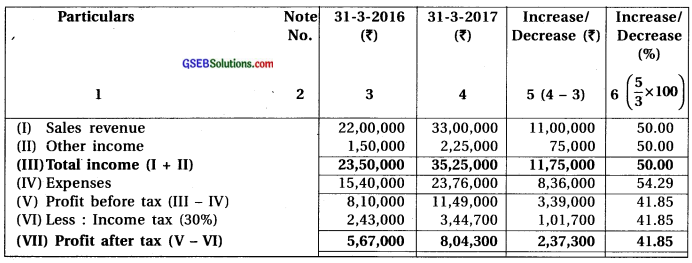
Question 5.
The abridged profit and loss statement ending on 31-3-2016 and 31-3-2017 of Srushti Company Limited are given as follows. Prepare comparative statement of profit and loss :
| Particulars | Note No. | 31-3-2017 (₹) |
31-3-2016 (₹) |
| Sales revenue | 25,35,000 | 19,50,000 | |
| Other income | 2,85,000 | 1,90,000 | |
| Cost of goods consumed | 11,40,000 | 9,50,000 | |
| Financial cost | 90,000 | 1,50,000 | |
| Depreciation | 60,000 | 60,000 | |
| Other expenses | 4,25,000 | 3,40,000 |
Income tax rate is 30%.
Answer:
Comparative Profit-Loss Statement of Srushti Company Limited for the year ending on 31-3-2016 and 31-3-2017

Question 6.
Profit and loss statement for the year ending on 31-3-2016 and 31-3-2017 of Shankar Limited are given as follows. Prepare comparative statement of profit and loss.
| Particulars | Note No. | 31-3-2017 (₹) |
31-3-2016 (₹) |
| Sales revenue | 60,75,000 | 45,00,000 | |
| Other income | 7,00,000 | 10,00,000 | |
| Expenses : | |||
| Cost of goods consumed | 36,00,000 | 30,00,000 | |
| Net purchase for resale | 2,70,000 | 2,00,000 | |
| Changes in stock | 90,000 | 70,000 | |
| Employee benefit expenses | 5,60,000 | 4,00,000 | |
| Financial cost | 1,35,000 | 90,000 | |
| Depreciation and amortized amount | 1,05,000 | 70,000 |
Income tax rate 30%.
Answer:
Comparative Profit-Loss Statement of Shankar Limited for the year ending on 31-3-2016 and 31-3-2017
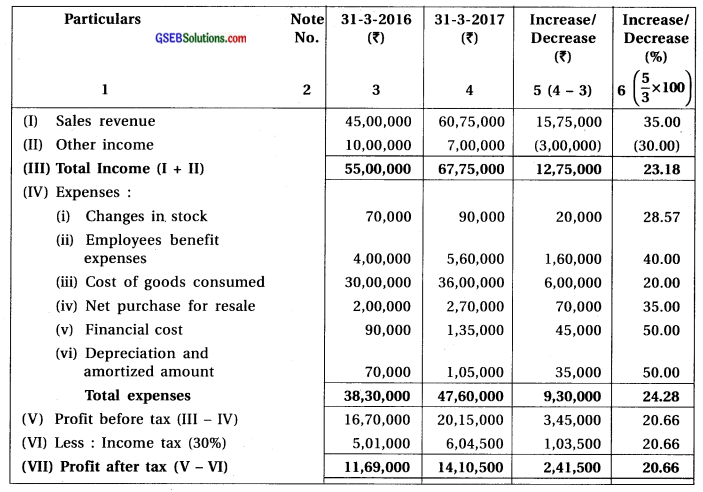
Question 7.
Profit and loss statement for the year ending on 31-3-2016 and 31-3-2017 of Mina Company Limited are as follows. Prepare comparative profit and loss statement.
| Particulars | Note No. | 31-3-2017 (₹) | 31-3-2016 (₹) |
| Sales revenue | 45,00,000 | 52,00,000 | |
| Other income | 2,00,000 | 10,00,000 | |
| ‘Net purchase | 32, 00,000 | 38,00,000 | |
| Other Expenses (% of sales) | 22 % | 18 % | |
| Changes in stock | 2,00,000 | 1,00,000 |
Income tax rate 30%.
Answer:
Comparative Profit-Loss Statement of Mina Company Limited for the year ending on 31-3-2016 and 31-3-2017
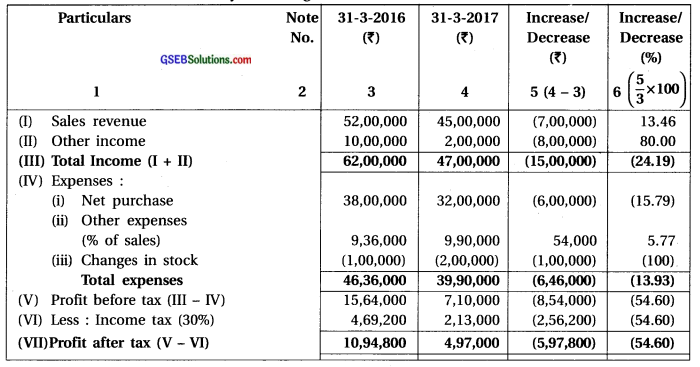
![]()
Question 8.
Find out balancing figures of comparative statement of Kalpana Company Limited.
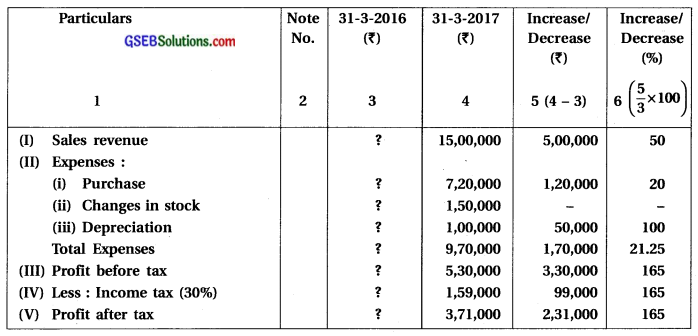
Answer:
Here, to obtain the missing figure of column No.3 we should deduct the amount of column No.5 from column No.4.
Comparative profit and loss statement of Kalpana Company Ltd. for the year ending on 31-3-2016 and 31-3-2017

Question 9.
Balance sheet of Small Company Ltd. as at 31-3-2016 and 31-3-2017 are as follows. Prepare comparative balance sheet.
| Particulars | Note No. | 31-3-2017 (₹) |
31-3-2016 (₹) |
| (I) Equity and Liabilities | |||
| (1) Shareholders’ funds: | |||
| (a) Share capital | |||
| (i) Equity share capital | 22,00,000 | 17,00,000 | |
| (ii) Preference share capital | 10,00,000 | 12,00,000 | |
| (b) Reserves and surplus | |||
| (i) General reserve | 2,40,000 | 2,00,000 | |
| (ii) Profit-loss account | 2,10,000 | 1,80,000 | |
| (2) Non-current liabilities | |||
| 10% debentures | 6,00,000 | 8,00,000 | |
| (3) Current liabilities | |||
| (i) Short-term borrowings | 90,000 | 45,000 | |
| (ii) Trade payables | 90,000 | 1,35,000 | |
| (iii) Other current liabilities | 70,000 | 70,000 | |
| Total | 45,00,000 | 43,30,000 |
| (II) Assets: | |||
| (1) Non-current assets : | |||
| (a) Fixed assets | |||
| (i) Tangible assets: Machines | 16,00,000 | 15,00,000 | |
| Furniture | 6,00,000 | 5,00,000 | |
| (ii) Intangible assets: Goodwill | 80,000 | 1,00,000 | |
| Patent | 7,50,000 | 7,30,000 | |
| (b) Non-current investments | 9,00,000 | 8,00,000 | |
| (2) Current assets : | |||
| (i) Stock | 1,80,000 | 1,60,000 | |
| (ii) Trade receivables | 1,80,000 | 2,00,000 | |
| (iii) Current investments | 1,40,000 | 2,70,000 | |
| (iv) Cash and cash equivalent | 70,000 | 70,000 | |
| Total | 45,00,000 | 43,30,000 |
Answer:
Comparative Balance Sheet of Small Company Limited as on 31-3-2016 and 31-3-2017
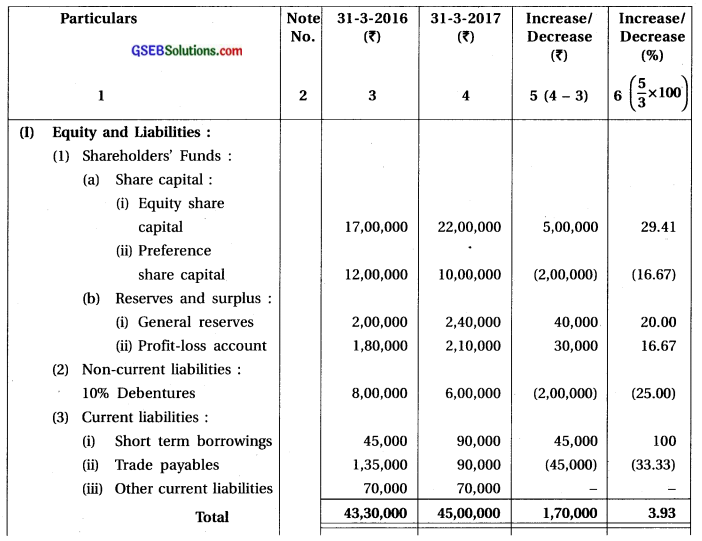
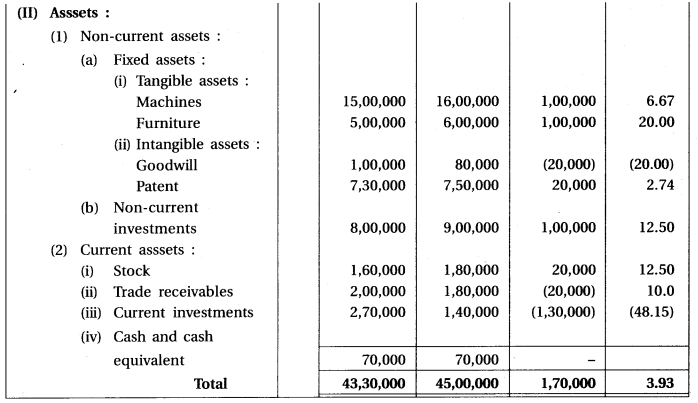
Question 10.
You are provided comparative balance sheets as at 31-3-2016 and 31-3-2017 of Shivani Company Limited ascertain balancing figures :
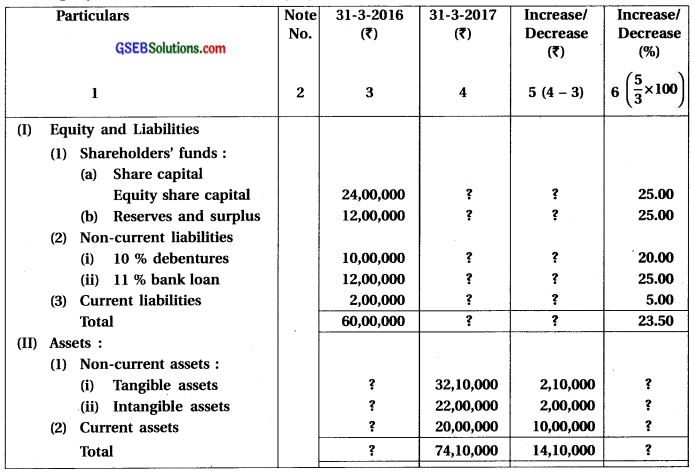
Answer:
The balancing figures are to be ascertained on the basis of amount and change in percentage of previous year.
Amount of current year = Amount of previous year \(\times \frac{(100+\text { change in percentage })}{100} \)
(1) Equity share capital = \( 24,00,000 \times \frac{100+25}{100}=\text { ₹ } 30,00,000\)
(2) Reserve and surplus = \(12,00,000 \times \frac{100+25}{100}=₹ 15,00,000 \)
(3) 10% Debentures = \(10,00,000 \times \frac{100+20}{100}=\text { ₹ } 12,00,000 \)
(4) 11% Bank loan = \(12,00,000 \times \frac{100+25}{100}=₹ 15,00,000 \)
(5) Current Liabilities = \(2,00,000 \times \frac{100+5}{100}\)
Comparative Balance Sheet of Shivani Company Limited as on 31-3-2016 and 31-3-2017
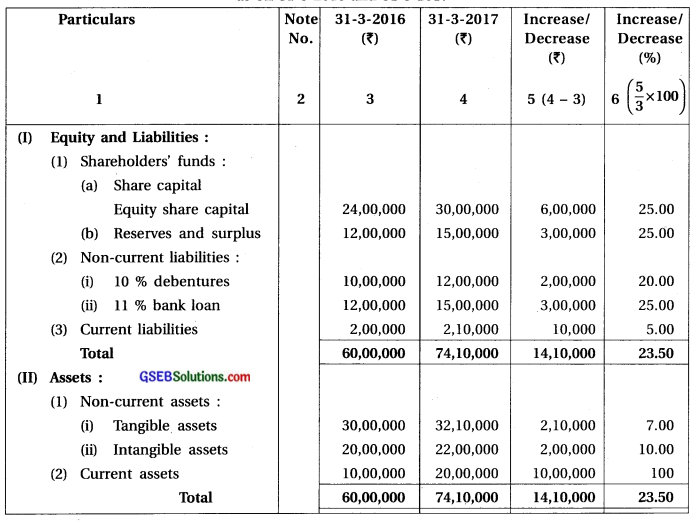
Question 11.
Prepare common size statement of profit and loss from the following profit and loss statements of two years.
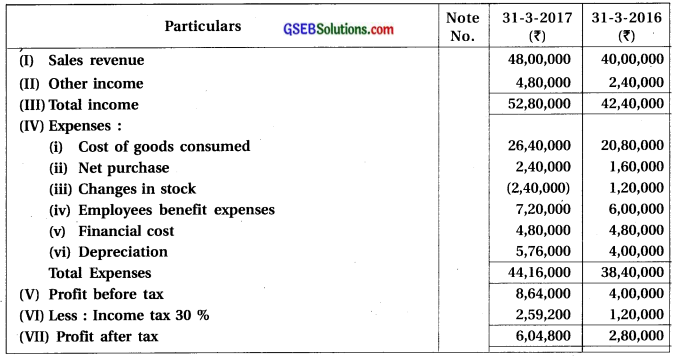
Answer:
Common size statement of profit and loss for the year ending on 31-3-2016 and 31-3-2017

Note:
(1) Here, percentage of other income is found out with respect to sales.
(2) Changes in stock shows negative answer i.e. closing stock is more than the opening stocks.
(3) Other incomes are included in the profit before income tax.
∴ The total of the % of the total expenses and % of net profit before tax is not 100%.
![]()
Question 12.
Find out balancing figures of common size profit and loss statements of two years :
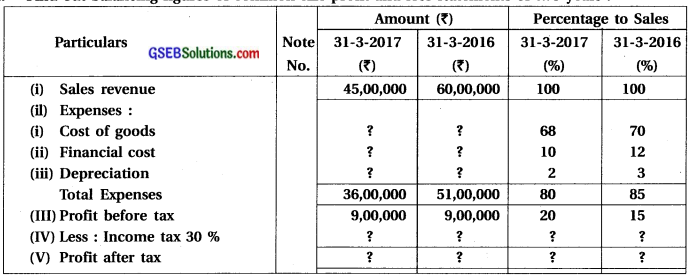
Answer:
In this sum, in place of the amount of expense their percentage to sales are given. On the basis of percentage, the amount will be determined. This will be calculated as follows :

Answer:
Common size statement of profit and loss statement of Limited Company for the year ending on 31-3-2016 and 31-3-2017
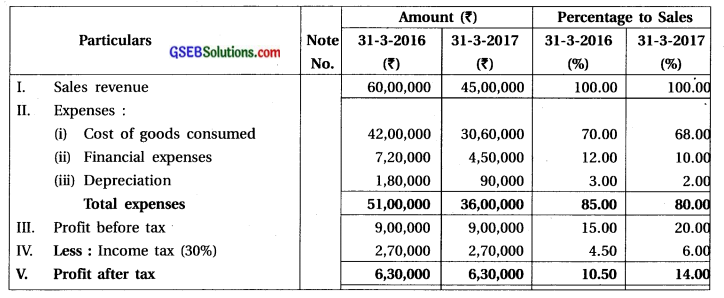
Question 13.
Balance sheets of two years of Saurashtra Limited are as follows. Prepare common-size statements.
| Particulars | Note No. |
31-3-2017 (₹) |
31-3-2016 (₹) |
| (I) Equity and Liabilities : | |||
| (1) Shareholders’ funds : | |||
| (a) Share capital: | |||
| (i) Equity share capital | 25,00,000 | 25,00,000 | |
| (ii) Preference share capital | 15,00,000 | – | |
| (b) Reserves and surplus : | |||
| (i) General reserve | 8,00,000 | 6,00,000 | |
| (ii) Profit-loss account | 4,50,000 | 6,00,000 | |
| (2) Non-current liabilities: | |||
| 9 % bank loan | 15,00,000 | 15,00,000 | |
| (3) Current liabilities : | |||
| (i) Short-term borrowings | 6,00,000 | 2,00,000 | |
| (ii) Other current liabilities | 1,50,000 | 6,00,000 | |
| Total | 75,00,000 | 60,00,000 |
| Particulars | Note No. |
31-3-2017 (₹) |
31-3-2016 (₹) |
| (II) Assets : | |||
| (1) Non-current assets : | |||
| (a) Fixed assets | |||
| (i) Tangible assets : | |||
| Machines | 15,00,000 | 20,00,000 | |
| Land-building | 25,00,000 | 15,00,000 | |
| (ii) Intangible assets : | |||
| Trademark | 5,00,000 | 3,40,000 | |
| Goodwill | 4,50,000 | – | |
| (b) Non-current investments | 15,00,000 | 15,00,000 | |
| (2) Current assets : | |||
| (i) Debtors | 3,75,000 | 3,00,000 | |
| (ii) Stock | 3,75,000 | 2,40,000 | |
| (iii) Cash and cash equivalent | 3,00,000 | 1,20,000 | |
| Total | 75,00,000 | 60,00,000 |
Answer:
Common size Balance Sheet as on 31-3-2016 and 31-3-2017 of Saurashtra Company Limited
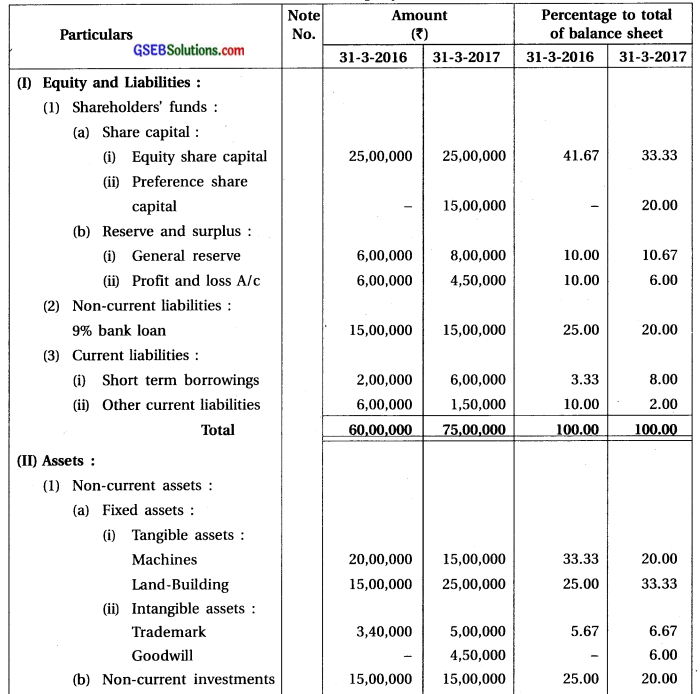

Question 14.
Balance sheets of two years of Shyam Limited are as follows. Ascertain balancing figures.
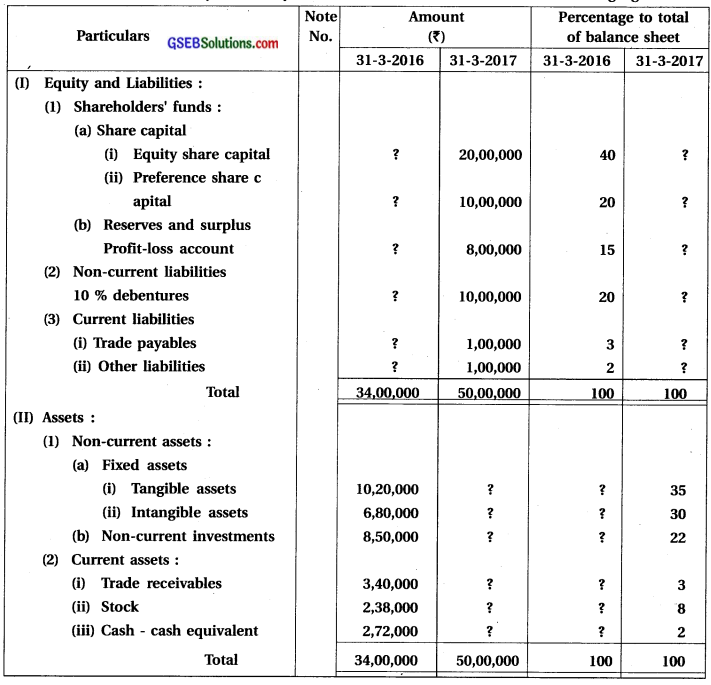
Answer:
Here, in place of amount, their percentage to total of balance sheet are given on the basis of percentage the amount will be determined as follows :
Amount of liability or asset of respective year :

Necessary Calculation :
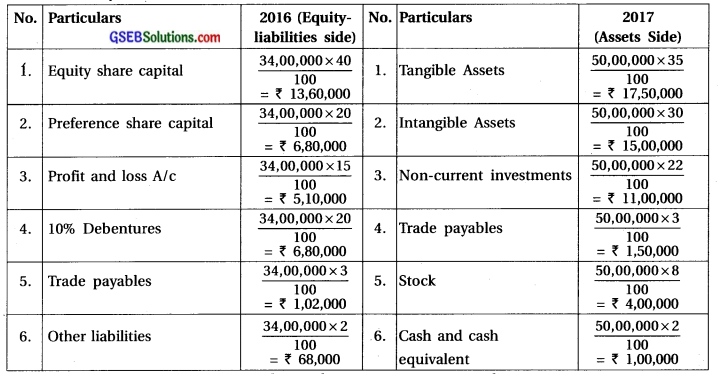
Common size Balance Sheet as on 31-3-2016 and 31-3-2017 of Shyam Limited
